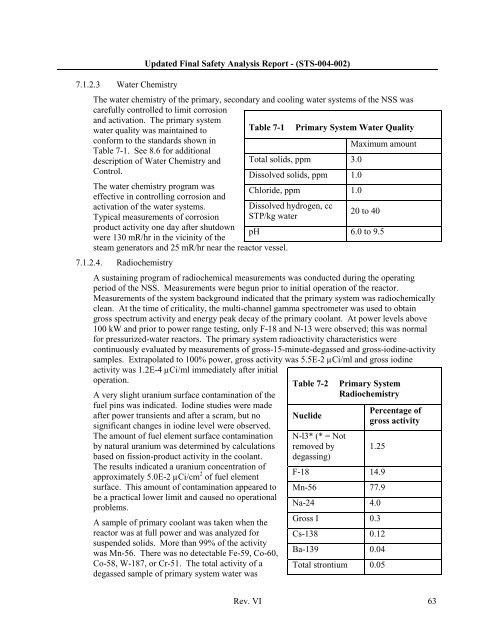10 CFR 50.71(e) - Maritime Administration - U.S. Department of ...
10 CFR 50.71(e) - Maritime Administration - U.S. Department of ...
10 CFR 50.71(e) - Maritime Administration - U.S. Department of ...
You also want an ePaper? Increase the reach of your titles
YUMPU automatically turns print PDFs into web optimized ePapers that Google loves.
7.1.2.3 Water ChemistryUpdated Final Safety Analysis Report - (STS-004-002)The water chemistry <strong>of</strong> the primary, secondary and cooling water systems <strong>of</strong> the NSS wascarefully controlled to limit corrosionand activation. The primary systemwater quality was maintained to Table 7-1 Primary System Water Qualityconform to the standards shown inMaximum amountTable 7-1. See 8.6 for additionaldescription <strong>of</strong> Water Chemistry and Total solids, ppm 3.0Control.Dissolved solids, ppm 1.0The water chemistry program wasChloride, ppm 1.0effective in controlling corrosion andactivation <strong>of</strong> the water systems. Dissolved hydrogen, cc20 to 40Typical measurements <strong>of</strong> corrosion STP/kg waterproduct activity one day after shutdownpH 6.0 to 9.5were 130 mR/hr in the vicinity <strong>of</strong> thesteam generators and 25 mR/hr near the reactor vessel.7.1.2.4. RadiochemistryA sustaining program <strong>of</strong> radiochemical measurements was conducted during the operatingperiod <strong>of</strong> the NSS. Measurements were begun prior to initial operation <strong>of</strong> the reactor.Measurements <strong>of</strong> the system background indicated that the primary system was radiochemicallyclean. At the time <strong>of</strong> criticality, the multi-channel gamma spectrometer was used to obtaingross spectrum activity and energy peak decay <strong>of</strong> the primary coolant. At power levels above<strong>10</strong>0 kW and prior to power range testing, only F-18 and N-13 were observed; this was normalfor pressurized-water reactors. The primary system radioactivity characteristics werecontinuously evaluated by measurements <strong>of</strong> gross-15-minute-degassed and gross-iodine-activitysamples. Extrapolated to <strong>10</strong>0% power, gross activity was 5.5E-2 µCi/ml and gross iodineactivity was 1.2E-4 µCi/ml immediately after initialoperation.A very slight uranium surface contamination <strong>of</strong> thefuel pins was indicated. Iodine studies were madeafter power transients and after a scram, but nosignificant changes in iodine level were observed.The amount <strong>of</strong> fuel element surface contaminationby natural uranium was determined by calculationsbased on fission-product activity in the coolant.The results indicated a uranium concentration <strong>of</strong>approximately 5.0E-2 µCi/cm 2 <strong>of</strong> fuel elementsurface. This amount <strong>of</strong> contamination appeared tobe a practical lower limit and caused no operationalproblems.A sample <strong>of</strong> primary coolant was taken when thereactor was at full power and was analyzed forsuspended solids. More than 99% <strong>of</strong> the activitywas Mn-56. There was no detectable Fe-59, Co-60,Co-58, W-187, or Cr-51. The total activity <strong>of</strong> adegassed sample <strong>of</strong> primary system water wasTable 7-2NuclideN-l3* (* = Notremoved bydegassing)Primary SystemRadiochemistryPercentage <strong>of</strong>gross activity1.25F-18 14.9Mn-56 77.9Na-24 4.0Gross I 0.3Cs-138 0.12Ba-139 0.04Total strontium 0.05Rev. VI 63
















